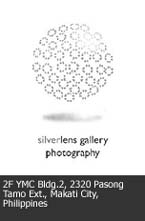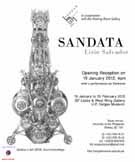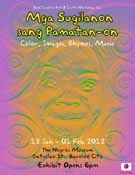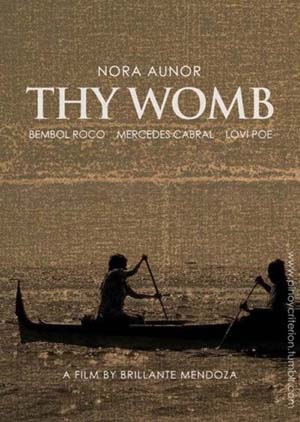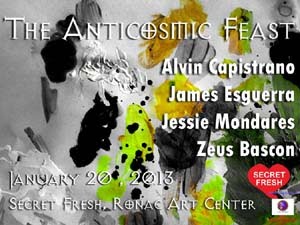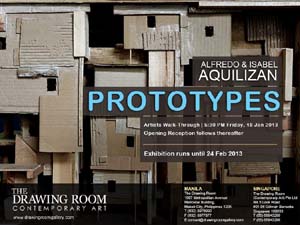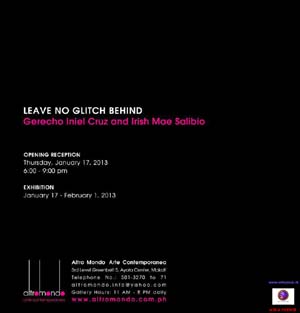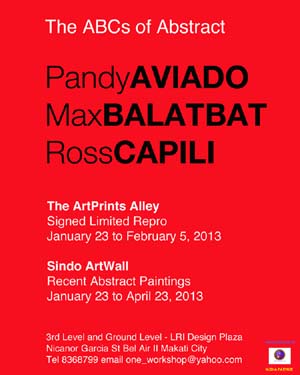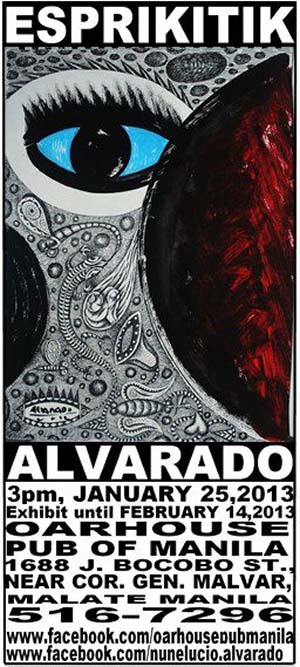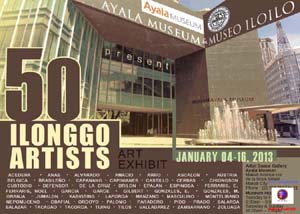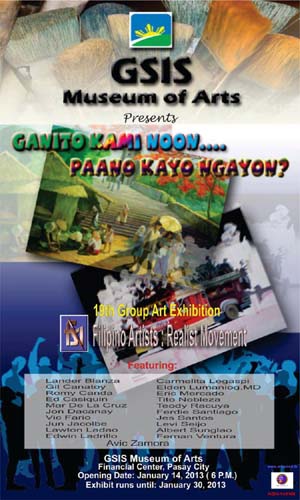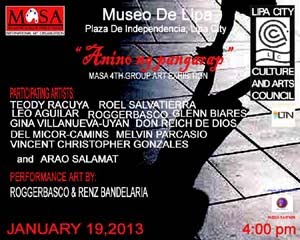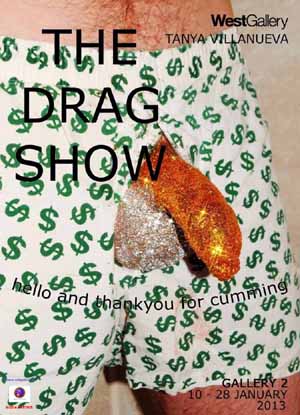
NEWS
Sunday, February 17, 2013
Thursday, February 14, 2013
YOU HAVE EVERY RIGHT
YOU HAVE EVERY RIGHT
February 16 – April 20, 2013
Opening Reception: February 16, Saturday, 4pm, Ateneo Art Gallery
Women Artists from Germany, Sweden, Australia, Denmark and Manila with a post-feminist edge are featured in an exhibition at the Ateneo Art Gallery from February 16-April 20. Opening reception is on Saturday, February 16, 4pm. The participating artists, Maria Cruz (Berlin/Sydney/Manila), Lizza May David (Berlin/Manila), Tracey Moffatt (Sydney/New York), Claudia Del Fierro (Chile/Sweden), Annika Eriksson (Berlin/Sweden), Lilibeth Cuenca Rasmussen (Copenhagen) and Kiri Dalena (Manila) have international careers that see them exhibiting around the US, Europe and Asia. Rasmussen was part of the Danish Pavillion at the 54th Venice Biennale, Del Fiero has was included in the 9th Havana Biennale in Cuba and the 4th Mercosul Biennial in Brazil, Moffatt has just recently had a solo exhibition at the MOMA New York, Eriksson was a part of the 2005 Venice Biennale, Cruz was a part of the PS1 International Studio Program in NY, Dalena’s video work was one of the select pieces to be included in the prestigious Short Film Festival in Oberhausen Germany and David has been shown widely in Europe and the Philippines.
The exhibition, YOU HAVE EVERY RIGHT, features contemporary female artists working with video, painting, photography, media and technology, creating process-oriented works that often involve collaborations, social interaction and the inclusion of real situations in their pieces. Their works reveals certain biographies wherein the personal becomes political. Manila, as a developing country, has been ranked high globally - as a country leading gender equality, closely following European counterparts. This makes it a very interesting point of interest for bold works that are open to in-depth research, chance and participation. This exhibition is curated by Lian Ladia.
Artist talks are also programmed to happen during the duration of the exhibition at the Ateneo Art Gallery (Feb 16, 2pm with Maria Cruz, February 17, 2pm with Lizza May David), The Ateneo Library of Women’s Writings (March 8, 2pm with Kiri Dalena), Alternative space 98B (February 17, 2pm with Claudia Del Fierro), and Green Papaya Art Projects (February 13, 7pm with Lilibeth Cuenca Rasmussen).
Wednesday, February 13, 2013
Monday, February 11, 2013
Sunday, February 10, 2013
Saturday, February 9, 2013
NEW YORK OLD MASTER AUCTIONS PREVIEW: SO MUCH TO SEE, SO LITTLE TIME
New York Old Master auctions preview: so much to see, so little time
Twelve sales in three days make the season a sprint rather than a stroll—but works by Batoni and Carracci are worth slowing down to see
By Paul Jeromack. Art Market, Issue 242, January 2012
Published online: 21 January 2013
Every year it gets worse. Each January, Sotheby’s and Christie’s New York
Christie’s
Christie’s big event is the Renaissance sale on 30 January, featuring paintings, drawings, prints and decorative arts. The star lot is a rare earlytondo by Fra Bartolommeo: The Madonna and Child, around 1495, in its original frame (est $10m-$15m). This is followed by not one, but two, Botticellis: the recently identified and very early Madonna and Child with a Pomegranate, painted in the early 1460s, when Botticelli was still in the studio of his teacher, Fra Fillippo Lippi (est $3m-$5m), and the “Rockefeller” Madonna and Child with the Young Saint John the Baptist, around 1493 (est $5m-$7m). More exciting is a later Italian painting—a rediscovered altarpiece of The Annunciation, around 1585, by Annibale Carracci, which until now was only known to the wider public from an old, undated black-and-white photograph.
Excluding the sketchy head studies and genre subjects of varying quality that appear at auction every so often and are attributed to various members of the Carracci family, paintings by Annibale are seldom encountered, and this well-preserved, relatively early work is of the highest quality, melding the influences of his cousin Ludovico, Titian and Correggio. It is the most important work by the artist to come to market since Boy Drinking, around 1582-83, which came from the Peter Jay Sharp collection and sold at Sotheby’s New York in 1994 for $2.2m, and which is now at the Cleveland Museum of Art. Christie’s estimates The Annunciation at $1.5m to $2.5m, which seems cheap.
Friday, February 8, 2013
OPEN IT AND THEY WILL COME. YOU HOPE…
Open it and they will come. You hope…
A number of galleries are making the move in search of the right area
By Charlotte Burns. Focus, Issue 242, January 2012
Published online: 16 January 2013
One of the great truisms about Los Angeles is the huge amount of cheap space available. But, in a city so vast and with such fast-moving cultural centres, finding the best place to establish a space can be complicated, according to galleries and LA real estate agents.
Culver City—cluster central
“When we moved here nine years ago, it cost $1 per sq. ft. Now it’s much more, though still affordable,” says Tim Blum, the co-founder of Blum & Poe. “If you are doing great things in a great space, serious people will show up. But to keep growing with your artists you’ll have to keep up on real estate moves because to be at the top of the heap you must have great space, great programming, great parking and be easy to find,” he adds.
After the gallery bought and renovated a building in the area, others followed, and Culver City remains one of the few real gallery hubs in Los Angeles. Nonetheless, real estate agent Martin McDermott of Avison Young says that while galleries in the area “got close to pulling off a solid location, it lacks parking and amenities—and things works best when restaurants and bars join in with the galleries”.
Thursday, February 7, 2013
KEEPING IT STRICTLY OLD SCHOOL
Keeping it strictly old school
LA teaching is still top for next generation of artists
By Charlotte Burns and Helen Stoilas. Focus, Issue 242, January 2012
Published online: 16 January 2013
Los Angeles’ art schools are the stuff of legend. Since the 1960s, students have flocked to the city to study under the likes of Allan Kaprow, Chris Burden, John Baldessari and Paul McCarthy. The system of artists teaching artists has made the city into a mecca for creative talent, although the local art market has struggled to establish itself as a major hub, and the city’s museums have yet to attract the visitors and patronage enjoyed by other centres such as New York or London. Such is the schools’ wealth and reputation that the Museum of Contemporary Art, Los Angeles (LA MoCA), recently embarked on discussions to create a partnership with the University of Southern California (USC), which is in the middle of an aggressive $6bn fundraising drive.
“LA is first and foremost a city where the schools dominate,” says Paul Schimmel, the former chief curator at LA MoCA. “The best and the brightest apply to LA because the schools have unprecedented success—if you get in, then you’re one step closer.”
“The MFA programmes attract a lot of talented young artists, but also established artists, fostering an intergenerational conversation. It is very Californian—the casual absence of hierarchy,” says Mieke Marple, the co-director of the Night Gallery.
The not-so-secret ingredient to the success of LA’s art schools is that the teachers are working artists themselves. “When you had people like Robert Irwin and Ed Moses teaching at UC Irvine in the 1960s, it demonstrated to the other schools that bringing in strong personalities creates a fulcrum around which you can build a programme,” says the director of the LA Louver gallery, Peter Goulds, who came to the West Coast as a University of California, Los Angeles (UCLA) visiting lecturer in 1972.
Wednesday, February 6, 2013
MUNICH TO GET ITS OWN FOURTH PLINTH
Munich to get its own Fourth Plinth
Scandinavian artists Elmgreen and Dragset are organising temporary art commissions in Germany
By Clemens Bomsdorf. Web only
Published online: 15 January 2013
Elmgreen and Dragset plan to bring their sculpture for Trafalgar Square’s Fourth Plinth to Germany. A replica of the artists’ boy on a hobbyhorse work, currently on view in London until April, is to be placed on Wittelsbacherplatz, a square in downtown Munich, as part of a €1.2m project to bring art in public spaces, organised by the Scandinavian artists. “For ages the Fourth Plinth was a problem for London. It just stood there, empty. Then it became one of the most fantastic art projects. Sometimes you need problems to get great ideas. Maybe Munich does not have enough problems, so we are bringing them one,” says Michael Elmgreen.
Elmgreen and Dragset have been commissioned by the German city to organise the temporary art project titled “A Space Called Public/Hoffentlich Öffentlich” (Hopefully public) starting 29 January and running until September. “We chose the two because they question public space with very unconventional projects and also have a good track record as curators,” says Hans-Georg Küppers, the director of Munich’s department of arts and culture.
The pair have invited other artists to participate, and the first work to go on view is Phantom by the British artist Stephen Hall, a reproduction of the empty Fourth Plinth itself. Other artists contributing to “A Space Called Public” include Kirsten Pieroth, Ragnar Kjartansson, Ivan Argote, Henrik Olesen, Han Chong and Peter Weibel.
Tuesday, February 5, 2013
ARTIST INTERVIEW, WALID RAAD: A MEDIATOR BETWEEN WORLDS
Artist interview, Walid Raad: a mediator between worlds
The artist challenges historical narratives in his Islamic-inspired show at the Louvre this month
By Louisa Buck. Features, Issue 242, January 2012
Published online: 15 January 2013
The art of Walid Raad uses the language and procedures of museums and academia—the archive, the slide show, the PowerPoint presentation, the wall-mounted information panel, the documentary photograph—to exude an air of informative authority. In his illustrated lectures and his multimedia installations this month at the Louvre, and, among other places, at the 2002 Whitney Biennial, the 2003 Venice Biennale, Documentas 11 and 13 and London’s Whitechapel Gallery, the 45-year-old artist comes across as a scholarly researcher-historian, examining the recent history of his native Lebanon and, over the past five years, the forging of art history in the context of the new art institutions proliferating in the Arab world.
In his latest project, Raad, who divides his time between Beirut and New York, where he is associate professor of art at the Cooper Union, continues to assume the role of a documenter and assembler of information and artefacts. “Walid Raad: Preface to the First Edition”, his new show in the Louvre’s Salle de la Maquette (19 January-8 April), consists of a video, a sculptural installation and a publication. They each take as their starting point the museum’s new department of Islamic art and its collection of 18,000 objects, some of which are destined to be loaned to the new Louvre in Abu Dhabi.
“These works are part of a larger, ongoing project that proceeds from the acceleration in the building of this new infrastructure for the arts in the Gulf, particularly in Abu Dhabi and Qatar,” Raad says, speaking on the telephone from his studio in New York. “I don’t know that much about Islamic art. All this is very new to me, but some of these objects I see in the display in the Louvre and at the Met—their lines, their forms and their colours—have been very productive for me. I saw the opening for a new kind of concept, a new creative act.”
This new concept manifests itself in Raad’s video, which features 28 Islamic artefacts from the Louvre that have been earmarked for its Jean Nouvel-designed sister museum on Saadiyat Island in Abu Dhabi. The video revolves around Raad’s notion that, “when these objects travel overseas, they will change in ways that are more insidious than the curators, conservators or museum directors could have predicted”. It is the story of these altered objects—how they have changed and why—that comprises Raad’s documentary film and the accompanying book, Preface to the Third Edition. “One person will be convinced that the objects themselves have changed and that change will only appear in certain photographs that this person will make,” he says.
Monday, February 4, 2013
ARISTOCRAT’S IMPRESSIONIST COLLECTION TO BE SOLD
Aristocrat’s Impressionist collection to be sold
Paintings by Monet, Sisley, Pissarro and Gauguin, estimated at more than £8m and assembled by ninth Earl of Jersey, to be auctioned at Sotheby’s next month
By Martin Bailey. Web only
Published online: 15 January 2013
Impressionist pictures owned by the Earl of Jersey are to be sold in London on 5-6 February. “They represent the best collection of Impressionism assembled by a British aristocrat,” according to Philip Hook, a senior specialist at Sotheby’s.
The ninth Earl of Jersey (1910-98) began to collect before the Second World War, initially under the influence of his second wife, the Hollywood actress Virginia Cherrill (she had been earlier married to actor Cary Grant). Most pictures were bought in the 1940s, initially for their house in Mayfair, in central London.
The two most important paintings coming up for sale are Monet’s snowscape Le Givre à Giverny, 1885, (est £4m-£6m) and Sisley’s La Tamise avec Hampton Church, 1874, (est £900,000-£1.2m). The Sisley, which has been recently cleaned, was done during one of the Paris-born artist’s visits to England.
Other works in the evening sale are Pissarro’s La Seine à Port-Marly, 1872, Monet’s Un moulin à Zaandam, 1871, Boudin’s Scène de plage à Trouville, 1868, and Gauguin’s La maison blanche, 1885, (est £800,000-£1.2m). The Gauguin appears to have been exhibited in the final Impressionist exhibition as “The Château of the English Lady”, which raises the intriguing question of who was owner of the house near Varengeville.
Sunday, February 3, 2013
ART BASEL HONGKONG EMBRACES ASIAN IDENTITY
Art Basel Hong Kong embraces Asian identity
Organisers announce the roll call for the first edition under new ownership
By Melanie Gerlis. Web only
Published online: 15 January 2013
Art Basel Hong Kong has announced the dealers who will be showing in what is officially its first edition (23-26 May). This is, in reality, a continuation of five years of growth of what was ArtHK, in which Art Basel acquired a controlling share nearly two years ago.
There are signs of some influence of the new parent company: the number of exhibitors is being “tightened”, says the Asian fair’s director, Magnus Renfrew (down from a total of 266 in 2012 to 245 this year), partly because dealers want larger booths in which to show their wares. There is also more emphasis on older works—in keeping with both the market’s trend away from contemporary art and Art Basel’s more historic presentation—but with a distinctly Asian feel. For example, says Renfrew, one newcomer this year is Tina Keng gallery, from Taiwan, a specialist in Asian modern masters; another is the Delhi Art Gallery, which will show work by modern Indian artists. Post-war Japanese work will be on view at the Los Angeles gallery Blum & Poe and New York’s McCaffrey Fine Art (both showing in the Hong Kong fair for the third year running). “There is a different aesthetic that can be difficult to understand, having more historical work should address that,” says Renfrew.
Organisers are keen to emphasise just how Asian this fair is; it had previously been criticised for neglecting its regional roots before its collector base was ready for the gloss (and prices) of the international art market. This year, organisers say that over 50% of galleries are from Asia and the Asia Pacific region—although this includes Western galleries that have set up shop in Asia, such as Gagosian and White Cube, both of whom recently opened in Hong Kong. The numbers are further swelled by the fair’s subsection Insights, which is dedicated to 47 galleries from Asia and the Asia Pacific region (including Turkey and the Middle East). But of the 171 galleries in the main section (and still using the criteria as above), the percentage of Asian galleries is still up, from 40% last year to 43% in 2013, considerably higher than at other international fairs.
Western newcomers this year include New York’s 303 and Peter Blum galleries, and Wentrup and Johnen Galerie from Berlin. Those not coming back include London’s Maureen Paley and New York’s Eleven Rivington, who both only exhibited at the fair last year, as well as art fair stalwart Cheim & Read (which has shown at the fair for the past two years and whose staff had Mandarin lessons prior to ArtHK’s 2011 edition). A spokesman for the gallery says they have decided to “take a year off”.
Saturday, February 2, 2013
PICASSO MURALS UNDER THREAT
Picasso murals under threat
Government contemplates tearing down buildings damaged during terrorist attack in Oslo
By Clemens Bomsdorf. Conservation, Issue 242, January 2012
Published online: 14 January 2013
The Norwegian Directorate for Cultural Heritage fears that Picasso’s first monumental concrete murals, which were made between the late 1950s and the early 1970s for two government buildings in Oslo, may be destroyed. The buildings were severely damaged during the deadly terrorist attack in the Norwegian capital in July 2011. The government is now considering whether to demolish the Modernist buildings that form the regjeringskvartal or government quarter.
“If the buildings were demolished and the murals integrated into new ones or brought to another site, they would no longer be the works Picasso intended,” says Jørn Holme, the head of the Directorate for Cultural Heritage.
After the attack on 22 July, Rigmor Aasrud, the minister for government administration, reform and church affairs, publicly asked whether it would be better to demolish the buildings. Holme and others think Aasrud’s question suggests that she wants to tear down the buildings, although a spokesman for the ministry declined to comment when approached by The Art Newspaper last month. A few months before the attack, the government and the directorate agreed that the buildings (known as Y- and H-block) should be listed, but moves to protect them were not followed up after the bombing.
The ministry has asked several architects to propose suggestions for the regjeringskvartal, providing options to both retain and demolish the buildings. The architects will present their proposals this summer. A report by the Directorate for Cultural Heritage concluded that, despite the bombing, the buildings are not unsafe and can still be used. “We still think that listing is appropriate. The buildings [are not only important] because of the works of art [that were] made especially for them, they are also a cornerstone in Norwegian architectural history and stand for the country’s development as a welfare state after the Second World War,” Holme says. The structu¬res were built in the 1950s and 1960s with breccia—a building technique using natural concrete—which was popular in Norway after the war.
Friday, February 1, 2013
HIGH SPIRIT
A Showcase of Women’s Excellence
“High Spirit” the art exhibition commences public exhibition on February 1, 2013 and will go on until March 27, 2013 at the Cultural Center of the Philippines
Aurora Go Bio Shakespeare, an industrial and graphic designer from Mallorca Spain Dubai
Mimi Tecson, who recently concluded a 3-month art residency in Yokohama Japan
Celine G. Borromeo, professor and interior designer, shows her landscapes in pastel and chalk, and illustrations “For Now and Lifetimes Ago” and “Circles with Open Ends.” Athena Santos Magcase Lopez, painter and children’s book illustrator from New Jersey
Rona Buenaseda-Chua, art teacher and owner of Rona’s Art Center
“High Spirit” the exhibition represents the spirit of excellence in various modes of articulation: free/disciplined, spontaneous/designed, playful/eloquent, stimulating/harmonious, ambiguous/lucid, constructive/analytic, meditative/narrative--- qualities that are seemingly contrary, but are not mutually exclusive. The artworks selected altogether inspire its viewers into looking at art as a humanly integrative and creative process.
The exhibition can be viewed at the CCP’s second floor hallway and little theatre lobby until March 27, 2013.
WRITER’S SHRINE TO GET EPIC TREATMENT
Writer’s shrine to get epic treatment
International team of artists and designers to create park dedicated to author of Master and Margarita
By Sophia Kishkovsky. Museums, Issue 242, January 2012
Published online: 14 January 2013
The Italian architect Gabriele Filippini and his Russian wife, Olga Moskvina, who won a competition run by the Moscow
The Mikhail Bulgakov State Museum , one of two institutions in Moscow
The novel, written between 1928 and 1940, was banned until the 1960s and censored for decades afterwards. It is a satirical portrait of life under Stalin that includes a mystical interpretation of philosophical questions. The main characters include the devil, in the guise of a mysterious visitor named Woland, and Begemot, a huge talking black cat. (A magnificent furry black cat holds court in the city-funded Bulgakov museum. He also spends time in the privately funded Bulgakov museum, which is in the same building, and is happy to be petted by visitors to both.) Christ, Pontius Pilate and Judas also feature in the novel, which is one reason why it was banned.
Tuesday, January 29, 2013
Monday, January 28, 2013
Wednesday, January 23, 2013
SERRA’S THREAT TO BROAD COLLECTION
Serra’s ‘threat’ to Broad collection
Curator argues artists’ law can place “moral rights” above
historical accuracy
By Laura Gilbert. News, Issue 242, January 2012
Published online: 10 January 2013
An independent curator has claimed that Richard Serra
threatened to withdraw one of his works from the collection of Eli and Edythe
Broad if he was not allowed to rework the drawing. Magdalena Dabrowski,
speaking to an audience of lawyers and art appraisers in New York
Dabrowski organised an exhibition of drawings by Serra at New York
Some of the drawings that Serra reworked had been damaged
or destroyed, and the artist recreated them specifically for the show. The Met
hinted at this by labelling the works with two dates: that of the original and
that of the reworked version. Serra says it is not important whether audiences
know which version they are seeing. “There’s no aura of originality because
it’s an anonymous surface. It’s a difference without a value. I try to keep
surfaces as anonymous as possible,” he tells The Art Newspaper. He says he
owned the drawings he recreated, and destroyed the works they replaced.
Tuesday, January 22, 2013
Monday, January 21, 2013
Sunday, January 20, 2013
WHAT’S IN STORE FOR THE MARKET
What’s in store for the market?
The growing numbers of the super-rich should keep the
auction houses happy in 2013, but there are tougher times ahead for some
By Georgina Adam.
Comment, Issue 242, January 2012
Published online: 10 January 2013
In January 2012, the outlook for the art market was bleak,
with turmoil in the eurozone and recession in many of the world’s major
economies. Nothing changed—at the macro level, at least—throughout the year, so
art dealers finished 2012 surprised that, for many, trade was not as bad as
expected. If anything, the results at the top end of the market have never been
better; more than $1bn was spent on art during last November’s sales in New
York, with Christie’s racking up an all-time record for a contemporary art
sale, at $412m. But will we witness similar success next year?
The 1% of the 1%
I believe the top end of the art market will continue to
perform strongly, particularly in the contemporary, Impressionist and Modern
art sectors. There are a number of reasons for this. First, the building of so
many museums across the world will sustain buying. Although the reported “1,000
museums” in China Middle East , with its huge
resources, wants to establish itself as a cultural hub on a par with other,
more established centres. And billionaires’ “vanity museums”—sometimes an
unfair criticism—need to buy top works of art as well.
In this context, a recent book by Chrystia Freeland,
Plutocrats: the Rise of the New Global Super-Rich and the Fall of Everyone
Else, 2012 (Penguin Press), offers a fascinating analysis of the new global
super-rich. She sees today’s incredible wealth as the result of two
transformations: technological revolution and globalisation in the West,
coupled with an Industrial Revolution-sized burst of growth in much of the rest
of the world, leading to the convergence of two “gilded ages”.
Saturday, January 19, 2013
BATTLE LINES DRAWN TO PROTECT VIEWS OF OLE LONDON
Preservationists square off with urban planners and
developers over building skyscrapers near heritage sites like the Tower of London
By Martin Bailey. Web only
Published online: 09 January 2013
The British government is facing criticism from Unesco for
allowing the Shard, Renzo Piano’s 95-storey commercial tower, and other
skyscrapers to be built so close to the Tower of London UK
Unesco’s World Heritage Committee last year recommended
that the UK
The Shard, which will have a public viewing gallery that is
due to open to visitors in February, now looms over the medieval walls of the Tower of London Tower
of London , across the Thames near London Bridge
Preserving the views around the Tower of London
The present situation, Penrose says, lacks clarity, which
makes it difficult for developers and offers insufficient protection for the
most important views. Two years ago, English Heritage published a report to
evaluate the significance of historic urban views. Penrose now wants a more
formal solution to the problem.
Friday, January 18, 2013
Thursday, January 17, 2013
ARTISTS PRESS FOR BETTER WORKING CONDITIONS ON SAADIYAT ISLAND
Artists press for better working conditions on Saadiyat Island
The group Gulflabor has released a new letter following a
report on labour practices at future museum sites
By Helen Stoilas. Web only
Published online: 09 January 2013
As construction begins on a new $653m branch of the Louvre
museum in Abu Dhabi , a group of artists who have
spoken out against labour conditions in the Gulf released another letter
calling on all the cultural institutions opening museums on Saadiyat Island
The emirate’s Tourism, Development & Investment Company
(TDIC), which is overseeing the massive cultural development project on Saadiyat Island
Wednesday, January 16, 2013
ISTANBUL BIENNIAL TO EXPLORE THE PUBLIC DOMAIN
Istanbul Biennial to explore the public domain
Organisers launch a series of forums across the city in
lead up to event
By Gareth Harris. Web only
Published online: 08 January 2013
In contrast to the Istanbul
According to a press statement, Erdemci’s highly academic
vision will explore “the notion of the public domain as a political forum”,
touching on the notions of democracy, civilisation, barbarity, and social
engagement. An aim of the biennial is to re-examine the concept of “publicness”
(installations may also be displayed in shopping malls, hotels and office
buildings).
Tuesday, January 15, 2013
ENGLAND’S RECORD £8.6bn LOANS
Fourfold increase in value of indemnified art borrowed—and
nearly all of it returned safely
By Martin Bailey. Museums, Issue 242, January 2012
Published online: 08 January 2013
Museums and galleries in England
The increase mainly reflects the rise in prices on the art
market, particularly for major works. However, the number of venues has also
increased, largely due to new National Lottery-funded buildings, such as Tate
Modern. Works lent to national museums accounted for 75% of the £8.6bn; loans
to other venues made up the rest.
We have obtained the first detailed data on the UK ’s Government Indemnity Scheme, which is
administered by the Arts Council in England
and by the respective governments of Scotland ,
Wales and Northern Ireland UK UK
Among the exhibitions in the past financial year that
pushed up the figure was the National Gallery’s “Leonardo da Vinci: Painter at
the Court of Milan” (9 November 2011-5 February 2012).
Although only eight paintings by Leonardo were borrowed
(plus works by other artists), the works were all extremely valuable.
Monday, January 14, 2013
MIRO ON LOAN DAMAGED AT TATE MODERN
Miró on loan damaged at Tate Modern
Cost of repairs and depreciation was £203,000
By Martin Bailey. Museums, Issue 242, January 2012
Published online: 08 January 2013
An important painting by Miró was damaged in 2011 while on
loan to Tate Modern, in an incident that went unreported in the media. The work
was on loan from the Fundació Joan Miró in Barcelona
According to a visitor to the Miró retrospective, a man
leant against the picture with both hands. A spokeswoman for the Tate says that
the gallery believes it was an accident. None of the gallery’s staff witnessed
the incident.
Painting on White Background for the Cell of a Recluse I,
1968 (above), is part of a room-sized triptych, and the left-side picture is
3.5m long. The incident occurred on 7 July 2011 and the painting went back on
display eight days later, after conservation work was completed by the Tate
with advice from the Miró foundation. The conservation work would have cost a
few thousand pounds, so the £203,000 indemnity payment by the UK
After London , the Miró
retrospective travelled to Barcelona Washington , DC
Sunday, January 13, 2013
POMPIDOU SHOW IN SHANGHAI POWER STATION CAUSES A STIR
Pompidou show in Shanghai Power Station causes a stir
Work by Andy Warhol and Malcolm Morley generate mixed
reaction
By Gareth Harris. Web only
Published online: 07 January 2013
A large-scale painting by Yan Pei-Ming, International
Landscape by Night, 2011, is on show in an exhibition organised by the Centre
Pompidou at the Power Station of Art in Shanghai ,
located on the banks of the Huangpu
River China
The show, displayed across the top floor of the
seven-storey building, examines the influence of Surrealism on contemporary art
through six sections, including ones on collage and automatism. Some of the
works on display, such as an explicit painting by Malcolm Morley Cradle of
Civilisation with American Woman, 1982, and Andy Warhol’s silkscreen Big
Electric Chair, 1967-68, raised eyebrows at the exhibition launch last month.
(Warhol’s portraits of Mao Zedong will not be included in a touring
retrospective, organised by the Warhol
Museum in Pittsburgh
Saturday, January 12, 2013
GRANADA’S ALHAMBRA THROWS OPEN DOORS TO WASHINHTON IRVING’S ROYAL CHAMBERS
Rooms where American writer stayed in Spain
By Javier Pes. Web only
Published online: 06 January 2013
Visitors this month to the Moorish palace overlooking the
southern Spanish city of Granada Alhambra lived in rooms that are part of a suite
built in the early 16th century when Charles V ruled Spain
Above the door of the room known as the Emperor's Study
there is a marble plaque commemorating Irving 's
extended visit to the Alhambra during what he
described as his "rambles" around the old cities of Spain
The opening of the rooms during January is part of the Alhambra
Subscribe to:
Posts (Atom)




























































